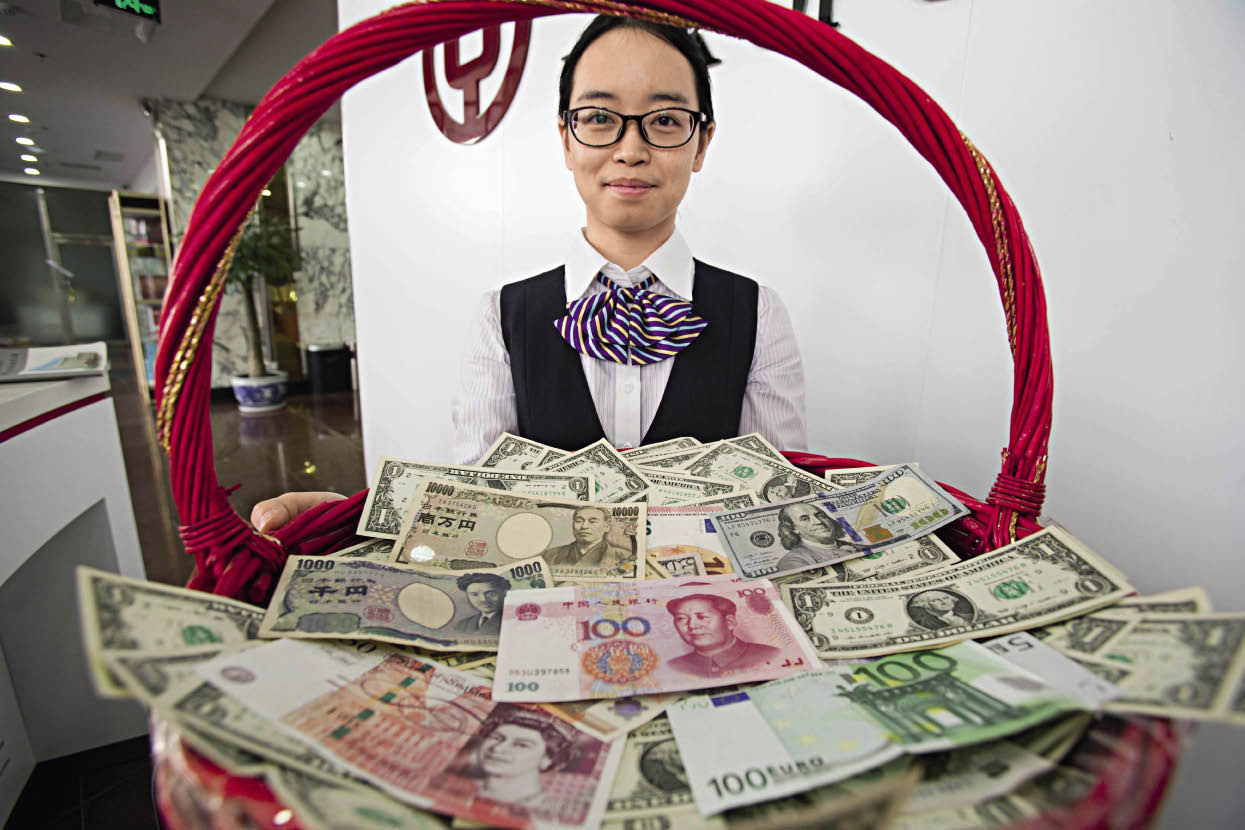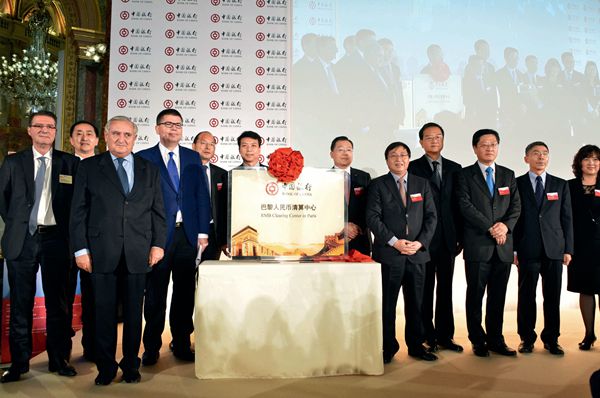By CHAI YIFEI
By CHAI YIFEI
ONE afternoon in mid-September, Chen Shi was at Frankfurt Airport, having just finished his trip to Europe. Seeing the long queue for tax reimbursement, he worried he would miss his flight, but to his surprise an airport worker called Chinese passengers to come forward for assistance, telling them that they could be reimbursed via Alipay!
“I had no idea I could use Alipay or a Union Pay account overseas,” said Chen, surprised that it was so easy. “All you have to do is write your name, passport number and Alipay account number – and there is no service charge.”
He filled in the necessary form, handed it in and went to catch his plane. Ten working days later, the tax rebate was transferred to his Alipay account in Renminbi (RMB).

The RMB is included in the IMF SDR basket as its fifth currency on October 1, 2016.
What amazed Chen Shi was just a small part of the rapid internationalization of the RMB. Last October, the International Monetary Fund (IMF) included the RMB in its new Special Drawing Rights (SDR) basket, which provides supplementary foreign exchange reserve assets. The RMB has now become a truly global currency, alongside the US Dollar, the Euro, the British Pound Sterling, and the Japanese Yen, and is a reserve currency for many countries and international organizations around the world.
This new status was not achieved overnight, however. The road to becoming a global currency has been rocky.
User-Friendly
Chen Shi was not just satisfied with the ease of his tax reimbursement with Alipay, but also impressed by how widely the RMB was accepted during his trip.
“I only exchanged 200 euros at the airport,” he explained, “because both my transportation and accommodation were paid online in advance. Many shops accept Union Pay and even give discounts to people using Chinese bank cards. Some label their prices in RMB too.”
Fu Hou is a Vietnamese student studying in China. She previously worked as a tour guide in her home country, and noticed that local people encouraged tourists to pay in RMB. When she took Chinese tour groups to the seaside, fishermen were selling buckets of shrimp, crab, fish, and shellfish with prices labeled in RMB. Some would even insist on tourists paying in RMB rather than Vietnamese Dong.
In Thailand, it is customary to leave tips in restaurants. Some Chinese tourists choose to pay in Thai Baht, while others tip in RMB. Waiters are happy to accept RMB. “China is the second largest economy in the world,” said a local waiter. “Chinese people have strong purchasing power around the globe, so there will be plenty of chances to use RMB. I’m not worried that I won’t be able to spend it.”
Marking China’s Economic Achievements
The IMF created the SDR in 1969. Originally, the value of 1 SDR was set at 1 US Dollar, which was equivalent to 0.888671 grams of gold. Since the collapse of that system in 1973, the SDR has become a unit of account for the IMF and provides supplementary foreign exchange reserve assets, defined by a “basket” of leading currencies, each weighted according to its current global prominence in international trade and foreign exchange. The RMB has been given a weighting of 10.92 percent, ranked third after the US Dollar and the Euro.
Including the RMB in the new basket, says Wen Bin, principal researcher for the China Minsheng Banking Corporation, “marks the enhanced international acceptance of the RMB, as well as the achievements of China’s economic reforms.”
Inclusion in the SDR basket is just one sign of the increasing acceptance of the RMB. It has been a long journey towards global prominence. Until quite recently the RMB was not circulated in foreign countries and Chinese nationals were given a foreign currency exchange limit.
According to UN data, in 1978 China only had US $1.6 billion in foreign exchange reserves, and by 1990 the figure was still a mere US $28.6 billion.
“To exchange foreign currency back then, one needed to apply to a foreign exchange administration, and sometimes it even took several months,” said Mei Xinyu, a researcher at the Chinese Academy of International Trade and Economic Cooperation under the Ministry of Commerce.
Easy RMB Transaction
All this was not very reassuring to foreign nationals using RMB. Mark is an American scholar who periodically attends seminars in China and visits Chinese colleges and universities as a guest lecturer. When he first travelled to this country 20 years ago, he took US dollars with him to change into RMB in the Bank of China. When he left, he exchanged all his remaining RMB into dollars because he would not be able to spend or exchange it in America, and he thought it was risky to deposit RMB.
“Now I don’t need to worry,” said Mark, brandishing his Union Pay card. Recently Mark has been working more closely with Chinese institutes of higher education, and he even prefers to be paid in RMB. He saves his salary in a Bank of China account and uses it whenever he visits China. “If I do take RMB back to America, it is not difficult to change it into dollars,” he said. “Besides, many stores in the U.S. now accept Union Pay.”
RMB payments have become more prevalent in international business. At Yiwu wholesale markets, a growing number of businesses are using RMB to settle accounts in deals with foreign merchants. Some directly use RMB to settle accounts in other foreign currencies, other than the US Dollar, such as the Russian rouble, which not only avoids exchange rate losses, but also cuts out the uncertainty of exchange fluctuations.

The Bank of China holds its launch ceremony in Paris on December 3, 2014 as a clearing bank for RMB business.
Take Volkswagen as an example: The majority of its transactions are conducted in euros, but the second largest number of transactions are made in RMB, which highlights the importance of the Chinese market and bilateral trade between Germany and China. According to Volkswagen China’s Public Relations Department, China is Volkswagen’s most significant market. In 2014, Volkswagen sold 3.7 million vehicles in China, which were all paid for in RMB.
Jaguar’s sales volume in China just keeps increasing. The British car manufacturer also embarked on a joint venture project with China’s Chery Automobile. Transactions using RMB have become an important feature of Jaguar’s corporate finance. According to Ben Burger Pauer, finance supervisor for Jaguar, the RMB is as important as other major currencies. “We use RMB for settlement, equity contribution, participation in profit, hedging, and cash investment. Actually in London, we already use RMB to manage almost everything we need to do.”
The Story of Internationalization
The internationalization of the RMB means greater convenience and benefits for Chinese spenders on overseas consumption, shopping and investment. In spite of this remarkable achievement, internationalization is still in its primary phase. Most organizations that use the RMB have close ties with China – very few are outside the bilateral link.
The inclusion of the RMB in the SDR basket has presented both opportunities and challenges. The weight of China’s influence and voice in international financial organizations relies on the stable and healthy development of its economy over the coming years.
According to Guo Tianyong, director of the Chinese Banking Industry Research Center at the Central University of Finance and Economics: “China has some problems with the RMB interest rate and controlling the exchange rate risk. The sluggish global economy, especially the devaluation pressure facing RMB, makes internationalization more difficult. Therefore, it is necessary to deepen domestic financial reform and improve the marketization of factor prices.”
As part of the SDR, the door of international reserve currency is now open to the RMB. However, there is a long way to go before this now eligible currency is universally well-received.
CHAI YIFEI is a reporter with People’s Daily (Overseas Edition).